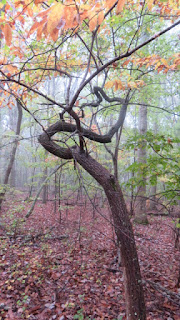Just 45 minutes away, it was my first visit to Cedarock Park. Alamance County acquired the property in 1972. It has a long early American history. Beginning in 1820, brothers Clint and Chris Curtis built what is now the Curtis House. A few years later, they constructed a 12 foot high stone dam on Rock Creek which powered a cotton mill. In 1830, John and Polly Garrett built a small one room cabin to live in while they took 5 years building a larger home. The Garrett family continued to live and own the property until 1930. The Garrett home and farm is now the centerpiece of the Cedarock Historic District. One of the more interesting stories of this place occurred during reconstruction. "Old Man Johnny" maintained KKK robes in the attic. KKK members would ride up on horses to "meet" at the farm. Old Man Johnny would make his way to the attic and pass the robes out using a pole.
Paul Stevens used German POWs quartered in Burlington to build stone walls.
The Curtis' cotton mill became a grist mill around 1850 when it was purchased by Huffman. It operated until 1880 and was removed in 1930. Things changed in a big way in 1930. A wealthy New York industrialist began purchasing the nearby farms, putting together a 414 acre estate. Paul Stevens came here from NY to help his wife's uncle with his cotton mill. Stevens eventually owned his own cotton mill in Burlington, Stevens Cotton Mill. He built a home atop a knoll near the old dam. He moved a smaller house onto the property - the Spoon house, to used as an office. He also acquired the Garrett farm. Stevens developed the property as a good gentleman farmer would, maintaining a stable of horses, tending some cattle and creating a system of bridle trails.
During my visit, I noted the impounded Rock Creek formed a horseshoe around his hilltop home. On the banks were a line of Cypress Trees as well as other ornamental bushes.
Not knowing what to expect out on the hiking trails, I was initially impressed by the size of some trees. Huge Oaks and Poplars make up the backbone of the forest. Sycamores dominate many of the open areas and, of course, the Cypress was totally unexpected. And then there were the Eastern Red Cedars. It didn't get called Cedarock for no reason. I understand a local resident suggested the name due to the number of cedars and rocks.
Cypress
The park refers to this as a waterfall!
There are between 5 and 6 miles of hiking trails. The system is based on 3 loop trails designed in a way, that you can hike a big 5+ mile loop utilizing the 3 component loops. A separate system of bridle trails also shares the forest but you rarely encounter the equestrian trails while hiking.
I left impressed and plan to revisit this place soon.
Our lunch spot
An interspecies marriage
























































